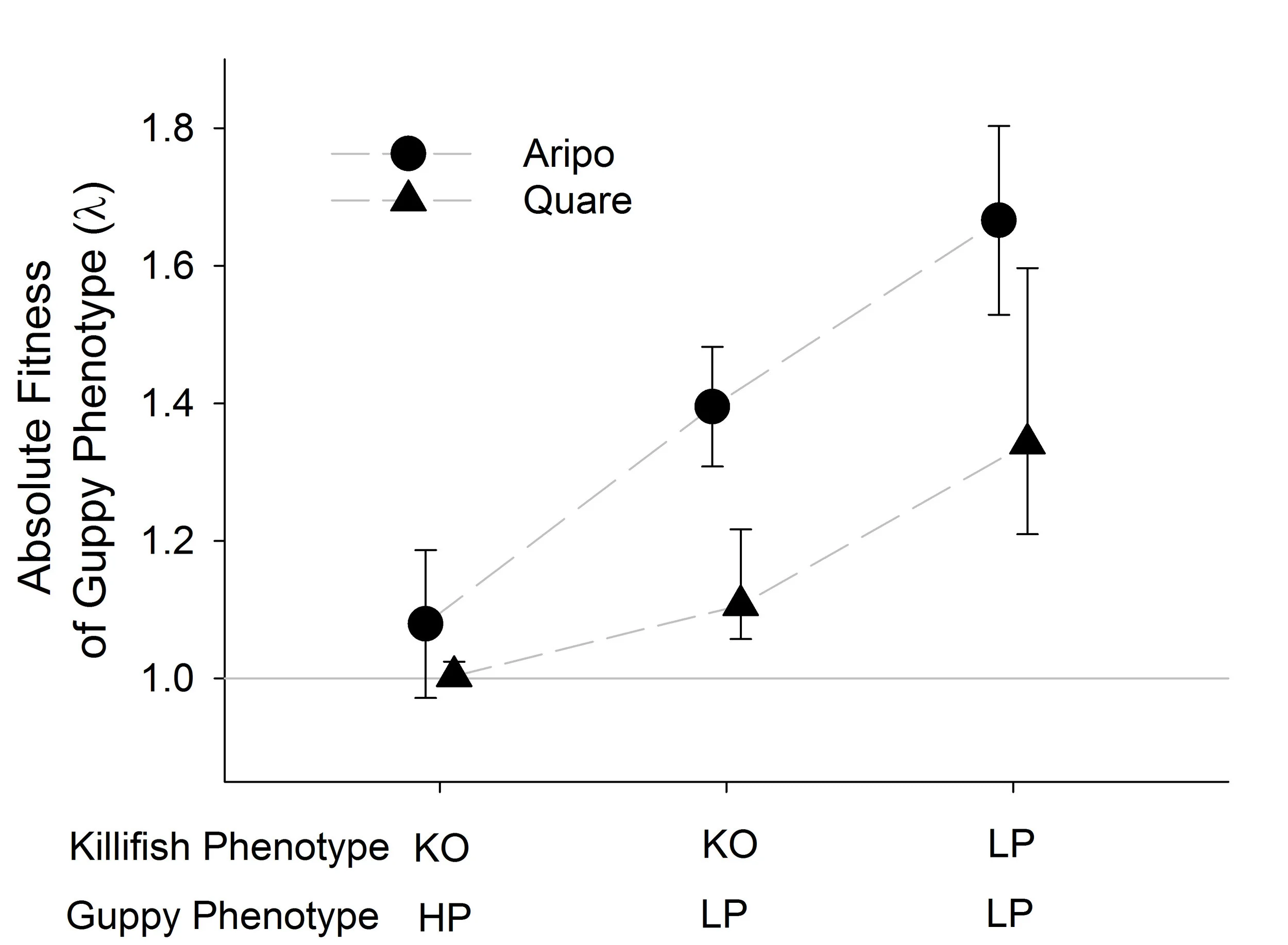Below you will find summaries of our research projects. If you wish to read more about these then click on the 'more information' link at the end of each section. For a general description of the empirical study system (Trinidadian fish communities), click here.
Absolute fitness of high predation (HP) and low predation (LP) guppies in the context of allopatric (KO) and sympatric (LP) killifish. Image from Bassar et al. 2017. Evolution.
Evolution of species coexistence in species with complex Life histories.
These projects are aimed at advancing our knowledge of species coexistence. We build theoretical models of size-structured eco-evolutionary interactions among competing species that make predictions about the conditions under which rapid evolutionary change can influence the likelihood of coexistence. We then use experiments of natural and experimental populations to test whether these changes are responsible for coexistence in a system where current theory says the species should not to coexist. Experimental components of the project will involve the Trinidadian guppy/killifish system. Theory and empirical evidence suggest that guppies and killifish should not coexist, but experimental introductions show that guppies can invade and coexist with killifish. Guppies and killifish evolve rapidly in response to introductions. Preliminary evidence suggests a role for evolution in coexistence. These results suggest that rapid evolutionary feedbacks may be necessary for invasion and coexistence in the guppy system. However, this is no more than a suggestion. more information
Standing stocks of algae in mesocosms with either low predation (LP) or high predation (HP) phenotype guppies at low and high densities. Image from Bassar et al. 2010. PNAS.
Community and ecosystem consequences of local adaptation
With the realization that evolutionary rates of change may be commensurate with ecological timescales, there has been an increasing interest in understanding the role of rapid local adaptation in structuring communities and ecosystems. In a series of factorial experiments in mesocosms combined with studies of wild populations, I have shown that locally adapted populations of guppies impact multiple components of the ecosystem in different ways. These effects are often as large as doubling guppy density. The significance of this research has been to show that rapid evolutionary changes reach far beyond the focal species itself, but reach far into the fabric of the local ecosystem. more information
Density and frequency dependent life history evolution.
The direct ecological and evolutionary effects of changes in the risk of predation have been well studied. For example, decreased mortality rates of a prey species can cause increases in their numbers and the evolution of changes in their reproductive schedules independent of changes in their numbers. However, changes in the population numbers of the prey can also exert selection on their reproductive schedules. I have shown that reduction in predator induced mortality strengthens intra-specific interactions and interactions with competitors, leading to unique selection pressures on the focal species. How the life history is then predicted to change in response to predator changes then depends on the balance between these direct causes of mortality, the indirect changes in competitive interactions and how these are distributed throughout life. The significance of this work is that it couples evolutionary and ecological changes resulting from changes in predation risk. more information
Brook trout life cycle. Image from Bassar et al 2015. Global Change Biology.
Mechanisms of climate driven dynamics of structured populations.
This work demonstrates how climate and biotic mechanisms interact to influence population dynamics and persistence. I combined mark-recapture studies of natural populations of brook and brown trout with statistical models (linear mixed models and Bayesian Markov chain Monte Carlo models) to parameterize age-, size-, and spatially-structured Integral Projection Models (IPMs). I am currently addressing questions related to how inter-annual seasonal environmental variation has caused changes in the demography of brook trout, how this environmental forcing influenced meta-population dynamics directly through somatic growth and survival and indirectly through altering density-dependent responses of the population. My results suggest that the vast majority of the observed yearly population growth rates of brook trout populations are the direct result of increased summer water temperatures decreasing the survival of juvenile fish, but that density-dependent compensatory mechanisms increase the per-capita probability of reproduction in the subsequent autumn. These density-dependent processes are weak in the sense that the major determinant of yearly population growth is due to the weather, but they are sufficient to keep the populations from extirpation under normal climate change scenarios. They are, however, insufficient to keep the populations from extinction under increased mean inter-annual summer water temperatures. more information



